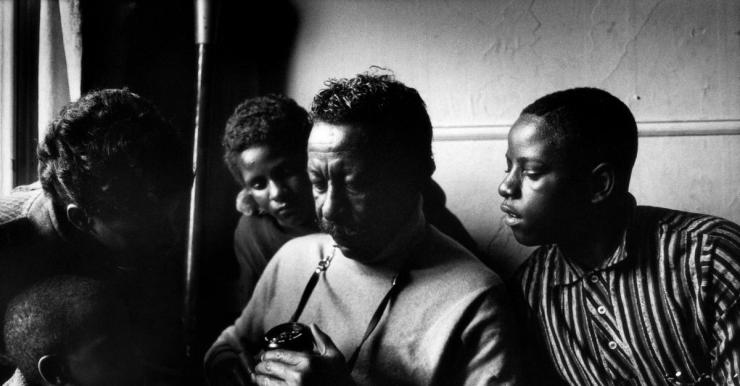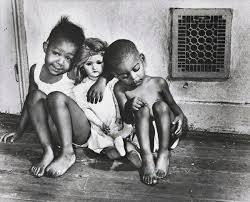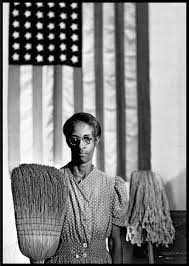When he died in 2006 at age 93, Gordon Parks was a famous man. He was known mostly as a photographer, but also as a filmmaker, writer and composer. His achievements were even more amazing because he was a black man who had grown up in poverty during the Great Depression. And much of what he became was influenced by his early years in Saint Paul.

Parks was born in Fort Scott, Kansas, the fifteenth child of a tenant farmer and his wife, a woman whose “strong conviction that dignity and hard work could overcome bigotry” bound the Parks family together, according to the obituary for Gordon Parks in the New York Times. Just before her death when Parks was 16, his mother told him to go to Saint Paul, Minnesota, to live with his sister Maggie Lee. She told him, “It’s a better world up there in the North. Color won’t work so hard against you,” according to Skip Berry in his biography of Parks. In fact, in Saint Paul Parks experienced extremes of human behavior that seesawed from extreme racism and cruelty to fortuitous kindness and generosity.

Parks arrived in Saint Paul not long after his mother’s funeral, and his sister took him in, but her husband treated him coldly and set strict rules for Parks to follow. Parks enrolled in Mechanic Arts High School,* got a job, joined a social club for young black men called the Diplomats, and was an instant success on the Diplomats’ basketball team, Berry says.
But soon he encountered trouble with his brother-in-law, who protested his going out two nights in a row.
Parks describes the scene in Voices in the Mirror, a memoir: “When my sister rushed to my defense he slammed her against the wall, and that sent me swinging for his belly. My blows only angered him more. Pouncing on me, he flung me to the floor and began to choke me. As my sister stood screaming, Crystal came to my rescue, beating on his head with an umbrella. When his hands fell loose I … ran out the door…. Several minutes later all my belongings, including my alarm clock and cardboard suitcase, came sailing out the window. And I charged about gathering them from the snow.”

With that, Parks entered a world of danger and deprivation. The weather that night was below zero, so he quickly found shelter in a nearby pool hall, but when the pool hall closed later, the only place he knew he could safely go with little money was the trolley. He spent the night riding the trolley for nearly a week. One night he was so desperate he nearly robbed a conductor who had a big wad of bills in his hand, but after pulling out a switchblade Parks was unable to continue and asked the conductor if he would buy the knife for a dollar. Parks fled the trolley in shame when the conductor offered to buy him some food.
On his way to high school one morning, Parks tells of competing with a dog for a dead pigeon, then roasting and eating it. Later during school he became sick and threw up, and vowed never to be so hungry again, he says. Then his fortune turned briefly; his sister had saved some money for him and he was able to rent a room. Overall, though, “It was a bleak time, and I ate anguish for breakfast and supper,” Parks says in the memoir. “It never struck me that I had three valuable assets—youth, health, and the inner need to someday amount to something. I was still overwhelmed with the complexity of surviving in a big city.”
At this point, not surprisingly, Parks’ feelings toward Saint Paul and the North in general were negative. “That past comes galloping in sometimes,” he says in his Voices memoir. “Angrily, it seems to point back at the smoke-filled pool hall, to the greasy eatery in Saint Paul where I washed a million dirty dishes every weekend, to a rat-infested flophouse on St. Peter Street where I mopped up the vomit of bums… It seemed as though I was serving out a sentence in hell.”

The wall of indifference Parks encountered was not limited by race. Parks said, “I never really expected much from the whites… But I hadn’t bargained for the cold shoulders of blacks. Yet, their ‘private’ clubs seemed as bigoted as those of the whites…. No hungry black boy would have gone unfed by other blacks in my hometown.”
The tide soon began to turn for Parks, however. Several other members of his family moved from Kansas to Saint Paul, he fell in love with the woman who was to become his first wife, and he landed a job as a busboy at the “wealthy, prestigious, white” Minnesota Club. There, he says, “I had the opportunity to observe what success was supposed to be, and to learn the rules I needed to know if I wanted to claim success.” There was plenty of food (leftovers) for him at the club, and he borrowed books from the club library to read. After a conversation about Parks’ interest in reading, Supreme Court Justice Pierce Butler gave Parks a copy of Edith Wharton’s The Age of Innocence.

The job at the Minnesota Club, however, ended very shortly after Black Friday in 1929, the stock market crash that made the Great Depression a reality. Parks cleaned out his locker at the high school and went to search for employment. Among other efforts, he went to Chicago, but by 1933 had returned to Saint Paul, where he got a job as head busboy at the Hotel Lowry. “It didn’t matter that I was the only busboy,” Parks wrote later. During the down time between lunch and dinner, he would play the large grand piano in the dining room. Soon, a white orchestra leader asked him what he was playing, and he said the song was “No Love,” which he had written about his breakup with his girlfriend Sally. Soon thereafter, the bandleader played the song on a national radio broadcast from the hotel, and that led to Parks’ employment with the band and his reconciliation with his girlfriend. Parks went to travel with the band, but it dissolved in New York and he ended up in Harlem for a while.
By 1934, Parks was back in Saint Paul and working for the North Coast Railroad as a porter, where through reading magazines left by passengers he developed an interest in photography. His photos were first displayed by an Eastman Kodak store in Minneapolis, but it was in Saint Paul where he talked himself into being hired as a fashion photographer, a role that would define his life for decades. He walked into Frank Murphy’s, “a fashionable store for women,” and asked to do fashion photos. Murphy’s wife offered him a chance to prove himself. Developing his film after the shoot (which he did with borrowed equipment), he found he had double-exposed all but one shot. At his wife’s suggestion (Parks and Sally were married by this time)—she “got out of bed when she heard me banging my head against the wall,” Parks said in his Voices memoir– he enlarged the one good photo and that earned him a regular job.

Marva Louis, the wife of heavyweight champion Joe Louis, noticed Parks’ photos in the Frank Murphy store windows and encouraged him to move to Chicago to continue his work, which he did. That led to work with the nation’s leading documentary photographers as a Julius Rosenwald fellow in the Farm Security Administration under the mentorship of Roy Stryker. That in turn eventually led him to his long-term work: he was the first African American to work as a staff photographer for Life magazine, a position he filled for more than 20 years (1948-1972). He also was a fashion photographer for Vogue magazine, at the same time documenting poverty and social issues. Later, he worked in both film and music, becoming the first black person to produce and direct a major Hollywood film, “The Learning Tree” (1969). He later directed the “Shaft” movies.

Whether Parks’ family remained in Saint Paul, and whether he returned to visit them after his fame grew, is not mentioned in his biographies or memoirs. Regardless, many of his formative years were spent in Saint Paul—for good and bad—and he did return in 1984 for an exhibition of his photographs at the Minnesota Museum of Art. In the exhibition catalogue, he wrote to then-director Jim Czarniecki, “With my sincere thanks for making me look magnificent—I had a marvelous [time] and, for the first time, enjoyed my own show.”
*He later also attended Central High School.


November 2007, revised November 2021

This is a lovely and interesting piece, Lisa!!
LikeLike
Thank you so much, Mary.
LikeLike
Thanks Lisa.
“ youth, health, and the inner need to someday amount to something” … and apparently an incredible talent.
When/how did he learn to play the piano?
Regards, Howard
>
LikeLike
He didn’t say when or where he learned it… maybe in the pool hall? Good question.
LikeLike
Now that’s a story! I enjoyed the PBS feature on him last year. Thank you, Dennis
LikeLike